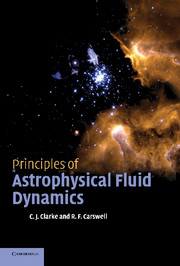Book contents
- Frontmatter
- Contents
- Preface
- 1 Introduction to concepts
- 2 The fluid equations
- 3 Gravitation
- 4 The energy equation
- 5 Hydrostatic equilibrium
- 6 Propagation of sound waves
- 7 Supersonic flows
- 8 Blast waves
- 9 Bernoulli's equation
- 10 Fluid instabilities
- 11 Viscous flows
- 12 Accretion discs in astrophysics
- 13 Plasmas
- Appendix Equations in curvilinear coordinates
- Exercises
- Books for background and further reading
- Index
10 - Fluid instabilities
Published online by Cambridge University Press: 05 June 2012
- Frontmatter
- Contents
- Preface
- 1 Introduction to concepts
- 2 The fluid equations
- 3 Gravitation
- 4 The energy equation
- 5 Hydrostatic equilibrium
- 6 Propagation of sound waves
- 7 Supersonic flows
- 8 Blast waves
- 9 Bernoulli's equation
- 10 Fluid instabilities
- 11 Viscous flows
- 12 Accretion discs in astrophysics
- 13 Plasmas
- Appendix Equations in curvilinear coordinates
- Exercises
- Books for background and further reading
- Index
Summary
Consider a fluid in a steady state, i.e. one which satisfies the hydrodynamic equations with ∂/∂t = 0 everywhere. If we find that small perturbations to this configuration grow with time, then our chances of finding the initial configuration in nature are very small, and the configuration is said to be unstable with respect to those perturbations. A stable configuration is one where either the perturbations diminish, or there is the possibility of oscillations or waves about the equilibrium configuration.
In this chapter we will be examining a variety of fluid instabilities. Such instabilities can often be invoked to explain the wealth of structure in astronomical images, as seen in e.g. Figures 9.7 and 9.8. More profoundly, the instabilities we discuss are responsible for such fundamental processes as convection in stars and the creation of the multi-phase state of the interstellar medium. Most importantly, the Jeans instability (Section 10.2) is responsible for the formation of the most important building blocks of the Universe – galaxies and stars.
Rayleigh–Taylor instability
In a Rayleigh–Taylor instability, an unstably stratified configuration of fluid layers overturns under the influence of gravity. This phenomenon is observed in many settings, including astrophysics, atmospheric and ocean science, and industrial processes.
Convective instability
The stability condition in the first case we consider is one which may be obtained by fairly simple arguments, and in particular without doing a perturbation analysis of the full hydrodynamic equations.
Information
- Type
- Chapter
- Information
- Principles of Astrophysical Fluid Dynamics , pp. 128 - 149Publisher: Cambridge University PressPrint publication year: 2007
